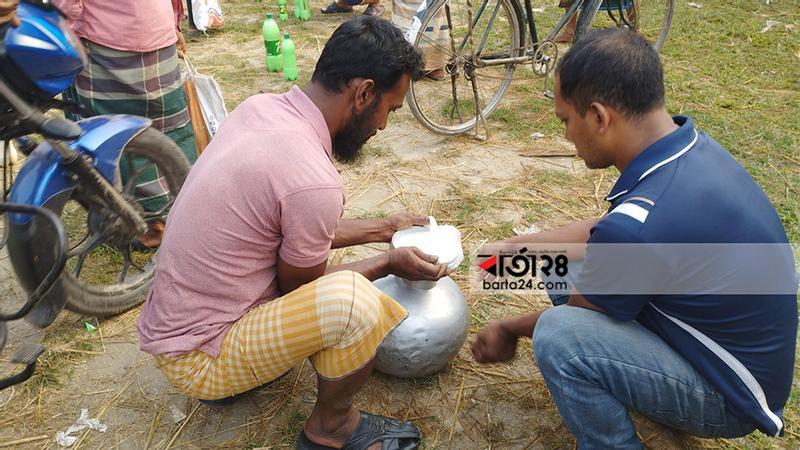The 'Shishu Bazar' of the British era is still going on in Katiadi

photo: Barta24
In Achmita Union of Katiadi Upazila of Kishoreganj, the ancient British-era Shishu Bazar still survives as a witness of time. Although the name is Shishu Bazar, it is actually a milk market. This traditional milk market has been meeting the demand of milk in the region for years.
Every morning buyers meet with wholesalers and retailers at the cow milk market. Here the farmers sell about 6-7 thousand liters of milk every day. Farmers are happy to get cash by selling milk.
Talking to the local elders, it is known that during the British period, the British used to visit the Achmita area. In Hossainpur and Jalalpur of Katiadi there was a blue hut.(Neel Kuthi). Among them, Jalalpur was the largest furnace in Asia. which still exists today. Considering the geographical advantage, the British started living in the present Achmita area by setting up some palaces. There is a legend that Shishu Bazar for milk is required for feeding their young children. Over time comes the Zamindari era. Then they also used to take milk from this market in the morning. This Bazar used to start from the crowing of dawn which is still going on for ages Today it is known as Shishu Bazar to the people of Ashmita.

The farmers who came to the market said that about a thousand farmers of the union raise dairy cows. They produce about 7-8 thousand liters of milk. Medium and small farmers bring milk to the market and sell milk to retailers and wholesalers. 8-10 wholesalers collect milk here.
Going to the market on Tuesday (May 7) morning, it is seen that farmers are bringing fresh milk by bi-cycle, rickshaw and CNG auto rickshaw. Someone is standing with a bottle, pitcher, jug, some brought two liters, some 10 liters, some brought more milk. Tk. 70-80 per liter is being retailed. Again wholesalers are buying milk and pouring it in drums. The sweet smell of milk is spreading in the air. The farmers got the price at the rate of Tk. 60-70 per litre. Most of the customers in the market are sweet sellers. Milk is collected and used to make sweets.

Zamir Uddin (75), a milk seller of Achmita village, said, 'Our fathers and grandfathers used to sell milk here. I have been watching since childhood. I do not know how old this market is. I am bringing three liters of milk. It feels good to sell and get cash.'
Madan Gopal, a buyer from Bajitpur said, 'I have been collecting milk from this market for 30 years. Ancestors also took from here. I bought 70 liters of milk for the sweet shop.
This Bazar runs from dawn to 9 am in Achmita Bazar next to the Katiadi-Kishoreganj regional road.















